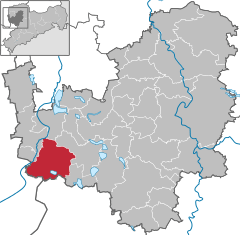Groitzsch
| Groitzsch | ||
|---|---|---|
|
Town hall | ||
| ||
 Groitzsch | ||
Location of Groitzsch within Leipzig district 
 | ||
| Coordinates: 51°9′20″N 12°16′50″E / 51.15556°N 12.28056°ECoordinates: 51°9′20″N 12°16′50″E / 51.15556°N 12.28056°E | ||
| Country | Germany | |
| State | Saxony | |
| District | Leipzig | |
| Government | ||
| • Mayor | Maik Kunze (CDU) | |
| Area | ||
| • Total | 70.06 km2 (27.05 sq mi) | |
| Population (2015-12-31)[1] | ||
| • Total | 7,626 | |
| • Density | 110/km2 (280/sq mi) | |
| Time zone | CET/CEST (UTC+1/+2) | |
| Postal codes | 04539 | |
| Dialling codes | 034296 | |
| Vehicle registration | L | |
| Website | www.groitzsch.de | |
Groitzsch (German pronunciation: [ˈɡʁɔʏtʃ]) is a town in the Leipzig district, in Saxony, Germany.
Geography and transport
The town is situated on the White Elster river, 20 km northeast of Zeitz, and 25 km southwest of Leipzig. The B176 goes through Groitzsch and the B2 goes through the subdistricts Kobschütz and Audigast. The new Bundesautobahn 38 is about 15 km away.
History
The original Sorbian name was Groisca.
The oldest archaeological finds in the town district date from approximately 4000 BC. After a dense settlement of the west Saxon region in prehistoric times, Slavic peoples migrated into this region after the migration of Germanic tribes in the 7th century, who appear in the sources as Sorbs. During the Ostsiedlung of the early Middle Ages, the populations mixed with settlers from Thuringia and Franconia. In the history of the town traces of Jewish life are also found.
The town was first mentioned in 1039 in the famous Pegauer Annals.
Notable people
References
| Wikimedia Commons has media related to Groitzsch. |

